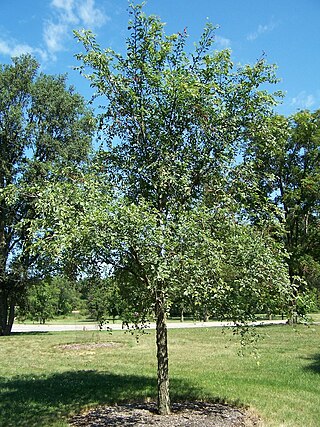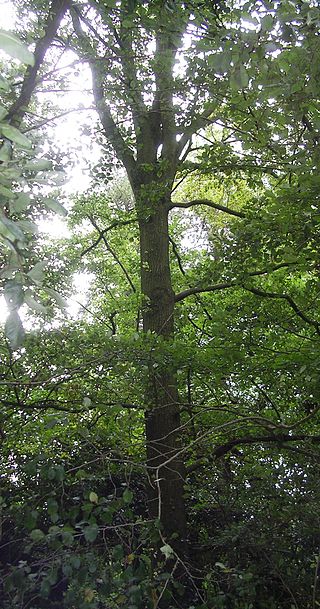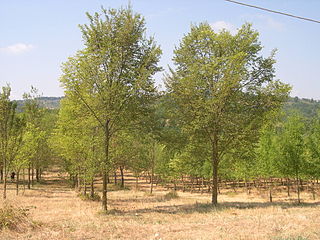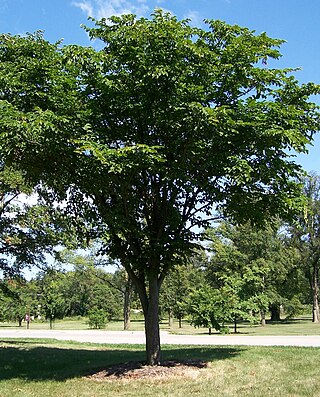
Ulmus 'San Zanobi' is a hybrid elm cultivar raised by the Istituto per la Protezione delle Piante (IPP) in Florence, from a crossing of the Dutch hybrid 'Plantyn' and the Siberian Elm Ulmus pumila clone 'S 15'; it was released to commerce in 2002. 'San Zanobi' was introduced to the UK in 2004 by Hampshire & Isle of Wight Branch, Butterfly Conservation, as part of its assessment of DED-resistant cultivars as potential hosts of the endangered White-letter Hairstreak.

Ulmus davidiana var. japonica, the Japanese elm, is one of the larger and more graceful Asiatic elms, endemic to much of continental northeast Asia and Japan, where it grows in swamp forest on young alluvial soils, although much of this habitat has now been lost to intensive rice cultivation.

Ulmus laciniata(Trautv.) Mayr, known variously as the Manchurian, cut-leaf, or lobed elm, is a deciduous tree native to the humid ravine forests of Japan, Korea, northern China, eastern Siberia and Sakhalin, growing alongside Cercidiphyllum japonicum, Aesculus turbinata, and Pterocarya rhoifolia, at elevations of 700–2200 m, though sometimes lower in more northern latitudes, notably in Hokkaido.

Ulmus uyematsuiHayata, commonly known as the Alishan elm, is endemic to forests at elevations of 800–2,500 metres (2,600–8,200 ft) in Alishan, Chiayi County, central Taiwan, where it is considered one of the minor tree species. The tree was first named and described by the Japanese botanist Bunzō Hayata in 1913, in the aftermath of the First Sino-Japanese War, when the Republic of Formosa was ceded to Japan.

Ulmus chenmouiW. C. Cheng, commonly known as the Chenmou, or Langya Mountain elm, is a small deciduous tree from the more temperate provinces of Anhui and Jiangsu in eastern China, where it is found at elevations below 200 m on the Langya Shan and Baohua Shan mountains. The tree was unknown in the West until 1979, when seeds were sent from Beijing to the De Dorschkamp research institute at Wageningen in the Netherlands.

Ulmus 'Lobel' is a Dutch hybrid cultivar raised at the Dorschkamp Research Institute for Forestry & Landscape Planning, Wageningen, from a crossing of clone '202' with '336'. 'Lobel' was cloned in 1962 and released for sale in 1973.

Ulmus 'Urban' is an American hybrid elm cultivar selected from the progeny of a controlled crossing of the Siberian Elm Ulmus pumila with the Dutch clone '148' in 1958 by Toru Arisumi of the USDA at Columbus, Ohio. Clone '148' had been sent to the US from the Netherlands in 1952 by Johanna Went, leader of the elm research team at the Willie Commelin Scholten Phytopathology Laboratory in Baarn.

Ulmus 'Wanoux' is a Dutch hybrid cultivar raised at the Dorschkamp Research Institute for Forestry & Landscape Planning, Wageningen, from an open pollination of 'Plantyn'. Originally identified as clone No. 762, it was selected for assessment by the French Institut National de la Recherche Agronomique (INRA), which patented it as 'Wanoux' in 2006.

Ulmus 'Columella' is a Dutch elm cultivar raised by the Dorschkamp Research Institute for Forestry & Landscape Planning, Wageningen. Originally thought to have been derived from a selfed or openly pollinated seedling of the hybrid clone 'Plantyn', DNA analysis later determined it arose from a cross of 'Plantyn' and Ulmus minor. Sown in 1967, it was released for sale in 1989 after proving extremely resistant to Dutch elm disease following injection with unnaturally high doses of the pathogen, Ophiostoma novo-ulmi. However, propagated by grafting onto wych elm rootstocks, graft failure owing to incompatibility has become a common occurrence in the Netherlands.

Ulmus 'Exoniensis', the Exeter elm, was discovered near Exeter, England, in 1826, and propagated by the Ford & Please nursery in that city. Traditionally believed to be a cultivar of the Wych Elm U. glabra, its fastigiate shape when young, upward-curving tracery, small samarae and leaves, late leaf-flush and late leaf-fall, taken with its south-west England provenance, suggest a link with the Cornish Elm, which shares these characteristics. The seed, however, is on the stalk side of the samara, a feature of wych elm and its cultivars, whereas in hybrids it would be displaced towards the notch.

The Japanese Elm cultivar Ulmus davidianavar.japonica 'Jacan' is a cold-resistant selection from Canada. The tree was raised by the Morden Research Station, Morden, Manitoba in the 1980s.

The Japanese elm cultivar Ulmus davidianavar.japonica 'Prospector' was originally treated as a cultivar of Wilson's elm U. wilsonianaSchneid., a species sunk as Ulmus davidiana var. japonica by Fu. A U.S. National Arboretum introduction, it was selected in 1975 from a batch of 1965 seedlings in Delaware, Ohio, and released without patent restrictions in 1990. 'Prospector' proved moderately successful in the US National Elm Trial, averaging a survival rate of 76% overall.

Ulmus 'Patriot' is a hybrid cultivar raised by the United States National Arboretum in 1980. Derived from a crossing of the American hybrid 'Urban' with the Wilson's Elm cultivar 'Prospector', 'Patriot' was released to commerce, free of patent restrictions, in 1993. Tested in the US National Elm Trial coordinated by Colorado State University, 'Patriot' averaged a survival rate of 85% after 10 years.

Ulmus 'Arno' is an Italian hybrid cultivar derived from a crossing of 'Plantyn' with the Siberian Elm Ulmus pumila clone S.2. It was raised by the Istituto per la Protezione delle Piante (IPP) in Florence, and released in 2007. However, 'Arno' was not a commercial success; propagation had ceased by 2010, and it is no longer patent protected.

Ulmus 'Fiorente' is a hybrid cultivar elm derived from a crossing of the Siberian Elm Ulmus pumila clone 'S.10' from Lucca, Italy, with the Ulmus minor clone 'C.02' from Lungarno, Florence, by the Istituto per la Protezione delle Piante (IPP), part of the Italian National Research Council, in Florence. The tree is protected by Plant Breeders' Rights bestowed by the EU on 25 March 2010.

Ulmus laciniata var. nikkoensisRehder, the Nikko elm, was discovered as a seedling near Lake Chūzenji, near Nikkō, Japan, and obtained by the Arnold Arboretum in 1905. The taxonomy of the tree remains a matter of contention, and has been considered possibly a hybrid of U. laciniata and U. davidiana var. japonica. However, in crossability experiments at the Arnold Arboretum in the 1970s, U. laciniata, a protogynous species, was found to be incompatible with U. davidiana var. japonica, which is protandrous.
The Istituto per la Protezione delle Piante (IPP), or 'Institute of Plant Protection', is part of the Food Department of the Consiglio Nazionale delle Ricerche, an Italian government organization with the aim of supporting scientific and technological research. IPP has four bases in Italy: Turin, Florence, Portici, and Bari.

Ulmus 'Morfeo' is a hybrid elm cultivar raised by the Istituto per la Protezione delle Piante (IPP), Florence, in 2000. 'Morfeo' arose from a crossing of the Dutch hybrid clone '405' and the Chenmou Elm, the latter a small tree from the provinces of Anhui and Jiangsu in eastern China, The '405' clone is a full sister of 'Groeneveld', a crossing of an English U. × hollandica and a French U. minor from the Barbier Nursery, Orléans.

The field elm cultivar Ulmus minor 'Ademuz' was cloned by root cuttings from a tree assumed to be growing in or near the eponymous town 100 km north-west of Valencia, Spain. The tree was discovered in 1996 by Margarita Burón of the Escuela Técnica Superior de Ingenieros de Montes, Universidad Politėcnica de Madrid (UPM). 'Ademuz' is one of a number of U. minor clones found to have a very high resistance to Dutch Elm Disease, on a par with, if not greater than, the hybrid cultivar 'Sapporo Autumn Gold' grown as a control. In the Madrid study, the appearance of the tree was rated 4.5 / 5, the most attractive of the seven selected cultivars.

Ulmus 'Wingham' is a complex hybrid elm cultivar featuring two Asiatic and two European species, bestowing it with an exceptionally high resistance to Dutch elm disease (DED). It was raised as clone no. FL493 by the Istituto per la Protezione delle Piante (IPP) in Florence, but never patented owing to its limited aesthetic appeal. It was introduced to the UK in 2011 by David Herling, Resistant Elms, who trialled it successfully at Wingham in Kent. It was later trialled by Hampshire & Isle of Wight Branch, Butterfly Conservation, as part of an assessment of DED-resistant cultivars as potential hosts of the endangered White-letter Hairstreak. 'Wingham' was released for sale in the UK in 2019.
























